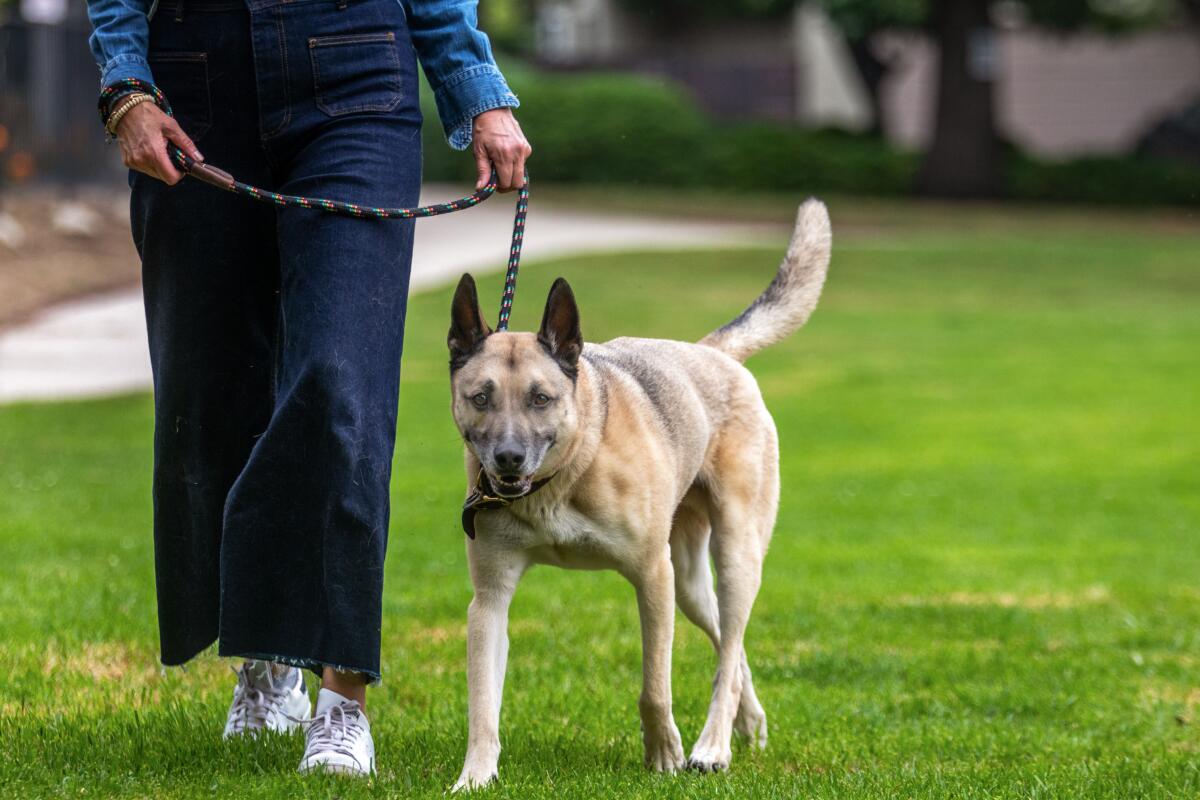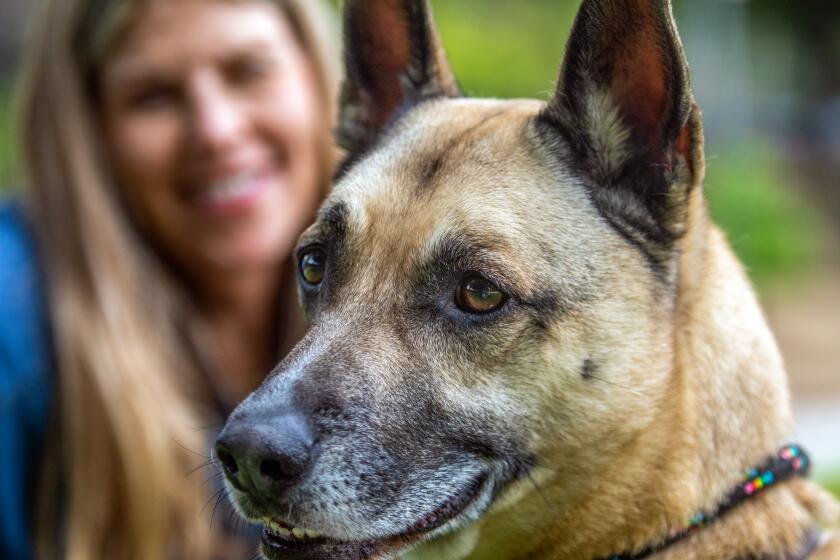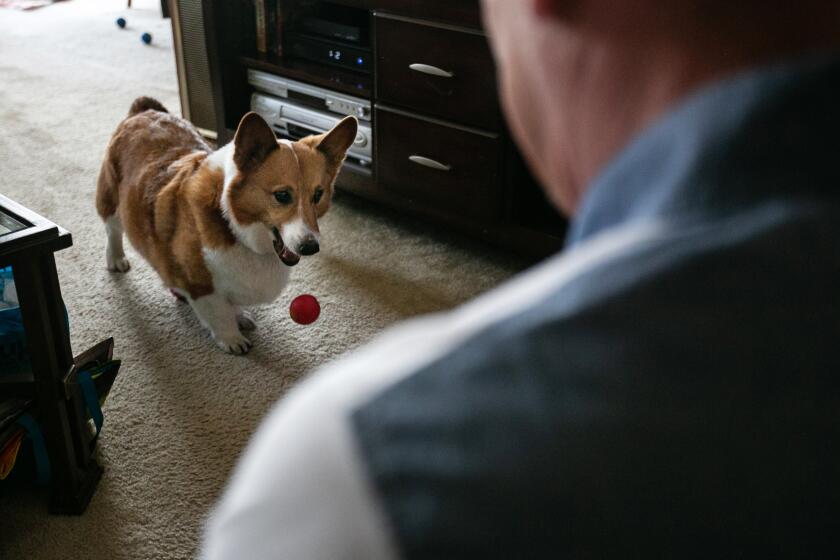When a dog bites, it’s probably because you weren’t paying attention

- Share via
Dog bites are sending record numbers of Californians to the emergency room. A recent study from the Department of Health Care Access and Information found that in 2022, the state saw an all-time high of 48,596 emergency visits for dog bites, a 12% increase from the year before.
Nearly half of American households — about 45% — have at least one dog. Many puppies were adopted hastily during the pandemic, then improperly trained and socialized, so now they aren’t functioning well. While these factors may be driving the increase in bites, most of these incidents can be prevented. Understanding dogs’ body language, properly training your animals and not rushing to pet other people’s dogs could go a long way toward reducing the likelihood of violent canine encounters.
After her rescue dog, Buddy, bit someone, Michelle Madden tapped bad-dog experts for help. Their advice made the situation worse, so Madden had to find another solution.
Vicious attacks by aggressive dogs are outliers. Most bites result from animals being put under stress and humans not understanding their signals. Although dogs generally aren’t dangerous, all of them — whether $1,000-dollar labradoodles or shelter mutts — might bite if they are stressed enough. Of the 4.5 million dog bites reported in the U.S. each year, an estimated 80% happen at home, typically involving a dog and a human who have met before.
The human’s story is often the same: The bite came out of nowhere. But there are almost always signs. We are just bad at reading them. Everyone knows to back away from a growl, but dogs usually communicate their discomfort long before reaching that point.
Dog aggression occurs on a ladder. Initial signs of discomfort might include lip-licking, looking away or yawning. Then dogs will escalate a step to behaviors such as stiffening up, staring or crouching with a tucked tail. When even the most conscientious dog owners don’t recognize the signs, then, seemingly out of nowhere, the dog reaches the top of the ladder, feeling left with no choice but to bite that handsy toddler or overzealous house guest. A dog that is poorly socialized or in pain will escalate far faster than a well-adjusted, healthy one.
After my cat died, I was in mourning. But working at an animal shelter offered some comfort and helped me better understand our feline friends.
Sometimes, though, there are no signs before a dog begins lunging and biting. That happens when the animal’s attempts to communicate are repeatedly punished — common in aversive training, which penalizes bad behavior with physical tools such as collars that deliver electronic stimulation, prong collars that dig into the skin and choke chains that constrict the neck. While not backed by science, this approach is still used in the unregulated dog-training industry.
Aversive techniques seem to work, but that’s deceptive. Fear-based learning can push dogs to stop engaging in any behavior, good or bad, because they are afraid to make a mistake and risk pain. This shutting down happens quickly and is easily mistaken for good behavior. But no growth has taken place, only intimidation and loss of trust, leaving a dog in the corner with no voice.
The consequences often surface through aggression, fear, anxiety and biting that seems to come out of nowhere if you’ve missed the signs. Fortunately, it is easy to recognize shut-down dogs: They are avoidant and disengaged, and appear stiff or cautious.
My wife and I once fostered a corgi to help its troubled owner, who became a friend. But what we thought was a happy ending was only a reprieve.
Effective techniques do not lean on physical punishment. Positive reinforcement training, the method backed by the American Veterinary Society of Animal Behavior, rewards dogs for what they do right, motivating good behavior via treats, toys, verbal praise and other options.
While you can teach basic commands like “sit” and “stay” in a day, solving more complex behavioral issues is a lifetime endeavor. The improvements may be too subtle to notice, unlike the seeming quick fixes of aversive training. But puppies that have proper training are better-adjusted throughout their lives.
And even good training is still only one-way communication through which dogs learn to listen to us. We also need to listen to them. On top of understanding the signals that lead to bites, it’s wise to remove a dog from a situation where it is displaying signs of distress. Dogs need a safe space at home to escape to when overwhelmed, especially in households with young children.
Finally, we should set and observe boundaries around petting. Don’t feel obligated to let other people pet your dog. Let’s also stop obsessing over petting other people’s dogs as soon as we meet them — and teach our children the same. Despite social media trends advising us to “pet all the dogs,” many are barely tolerant of strangers’ hands on them. Dogs that want your attention make it known, approaching with a wagging tail, soft eyes and a loose, wiggly body. If you’re the one who has to initiate the interaction, a good rule of thumb is: Don’t.
We love our dogs. We’re also responsible for them. We should respect all dogs as individuals with their own history, personality and triggers. Get to know their limits, meet them where they are, and you won’t give them a reason to send you to the ER.
Melonie San Pietro has a master’s degree in canine science and owns a small dog-walking business in Washington, D.C.
More to Read
A cure for the common opinion
Get thought-provoking perspectives with our weekly newsletter.
You may occasionally receive promotional content from the Los Angeles Times.












